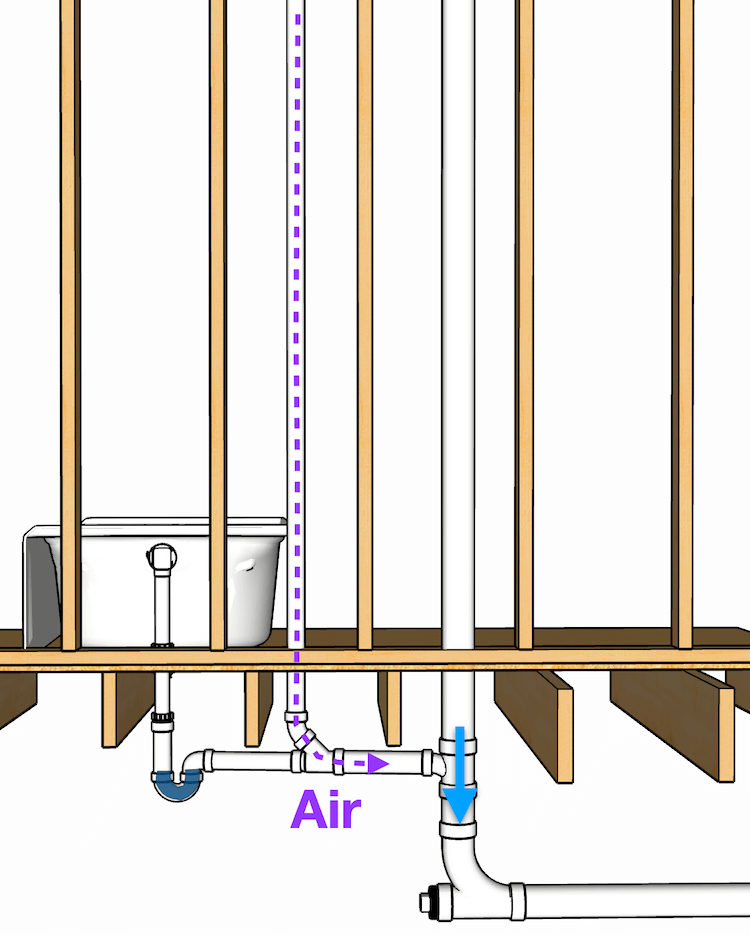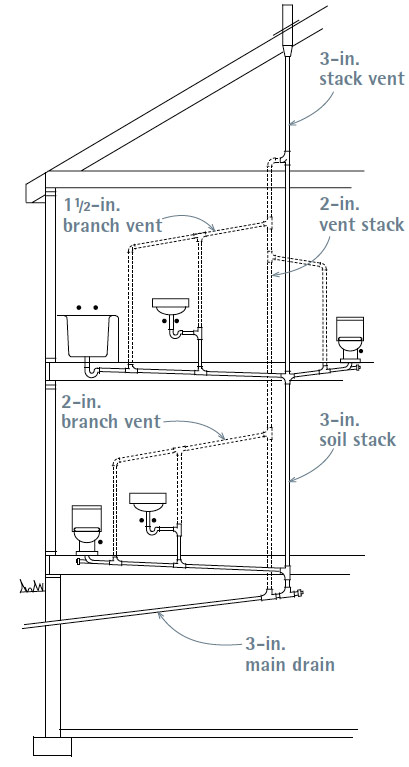The Advantages of Adequate Ventilation in Your Plumbing System
The Advantages of Adequate Ventilation in Your Plumbing System
Blog Article
What're your ideas regarding Essential Plumbing Vent Pipes: Understanding Their Role?

Proper ventilation in plumbing systems is typically neglected, yet it is important for keeping the performance and safety of your home's pipes. Ventilation helps control atmospheric pressure, protect against the buildup of dangerous gases, and guarantee the effective removal of waste. In this overview, we will certainly discover the importance of proper pipes ventilation, exactly how it works, and the benefits it brings to your pipes system.
Comprehending Ventilation in Pipes
Ventilation in plumbing describes the network of pipes that permit air to stream via the water drainage system. These vents serve numerous objectives, consisting of regulating atmospheric pressure within the pipelines, protecting against drain gases from going into the home, and helping in the smooth flow of wastewater.
Just How Air Flow Works in Pipes Solutions
Air Pressure Law
Proper air flow maintains well balanced atmospheric pressure within the plumbing system. When water moves through pipes, it displaces air. Without ample ventilation, this displacement can create negative pressure, causing reduce drains or siphoning of water from catches, which can create undesirable smells to leak into the home.
Protecting Against Sewage System Gas Accumulation
Among the most vital features of pipes vents is to stop sewer gases, such as methane and hydrogen sulfide, from accumulating within the home. These gases can present severe health and wellness threats and are extremely combustible. Vent pipelines allow these gases to leave safely outdoors.
Assisting in Waste Elimination
Air flow helps in the effective removal of wastewater by avoiding airlocks in the drain system. When air can move freely via the vents, it enables water and waste to flow smoothly through the pipelines, decreasing the threat of obstructions and backups.
Types of Pipes Vents
Key Stack Vent
The major stack vent, also referred to as the vent pile, is the key vent in a plumbing system. It prolongs from the main drain align with the roof covering, permitting gases to run away and fresh air to go into the system.
Branch Vent
Branch vents attach to the primary stack air vent and offer individual components, such as sinks, bathrooms, and showers. These vents make sure that each component has ample ventilation to function properly.
Air Admission Valve (AAV).
An Air Admittance Valve (AAV) is a one-way shutoff that enables air to get in the pipes system without the need for a standard air vent pipeline prolonging via the roof. AAVs are typically utilized in improvements or areas where setting up a common air vent is impractical.
Indications of Poor Air Flow in Plumbing.
Slow Draining Fixtures.
If your sinks, tubs, or toilets are draining pipes slowly, maybe an indication of bad ventilation. Inadequate air flow can develop a vacuum cleaner result, making it tough for water to drain properly.
Gurgling Appears.
Gurgling noises coming from drains pipes are usually an outcome of air being sucked via water catches as a result of adverse pressure in the pipes. This is a clear sign of not enough ventilation.
Undesirable Odors.
Sewer smells inside your home are a warning that your plumbing system is not correctly aerated. This can suggest that sewage system gases are not being properly vented outside, bring about potentially harmful conditions.
Usual Ventilation Errors.
Poor Vent Sizing.
Utilizing small air vent pipes can result in bad air circulation and stress inequalities in the system. It's important to make use of vents that fulfill the certain requirements of your plumbing system.
Improper Vent Positioning.
Putting vents too much from the components they serve can minimize their effectiveness. Appropriate positioning ensures that air can flow openly and effectively through the system.
Disregarding Code Requirements.
Building regulations offer details standards for pipes air flow. Overlooking these codes can cause a system that stops working to work appropriately and might bring about pricey repairs or health hazards.
Advantages of Appropriate Air Flow.
Enhanced System Performance.
Properly aerated pipes systems operate extra efficiently, with fewer blockages, faster draining pipes, and less strain on the pipelines. This performance expands the lifespan of the plumbing system.
Improved Air Top Quality.
By avoiding drain gases from entering your home, correct ventilation adds to much better indoor air quality, making your living environment healthier and a lot more comfy.
Avoiding Water Damage.
Ample ventilation aids prevent water from being siphoned out of catches, which can lead to drain gases going into the home and causing water damages with time.
Actions to Ensure Appropriate Air Flow.
Consulting Plumbing Codes.
Always get in touch with neighborhood plumbing codes when designing or changing your pipes system. These codes supply the necessary standards for appropriate airing vent and ensure your system fulfills security standards.
Routine Evaluation and Maintenance.
Regular assessments can help determine prospective air flow issues before they become major problems. Maintenance jobs, such as cleaning air vent pipes and looking for blockages, are vital for keeping the system in good working order.
Expert Setup.
For new installments or significant alterations, it's important to hire an expert plumbing professional. They have the proficiency to make certain the air flow system is correctly made and set up according to code.
Conclusion.
Appropriate air flow is an essential part of any kind of pipes system, ensuring that it functions successfully and safely. By comprehending the relevance of air flow, acknowledging the indications of poor air flow, and taking actions to maintain your system, you can avoid expensive issues and shield your home's air quality.
4 Things You Should Know About Your Plumbing Vents
What Plumbing Vents Are
Also called a vent stack, a plumbing vent is a vertical pipe attached to your drain line that runs through your roof. The plumbing vent pipe, or plumbing air vent, removes gas and odors from your plumbing system and allows fresh air to enter the pipes, helping the water to flow out of the drain pipes.
What Plumbing Vents Do
Plumbing vents have two basic functions. One of which is to allow unpleasant smelling wastewater and sewer gasses to escape your plumbing system instead of entering your home. Plumbing vent pipes are typically located on roofs, away from windows, to ensure the fumes exit the home completely.
The other function of the plumbing vent is to move fresh air into your plumbing system. This helps move water through every plumbing fixture in your house, like toilets and sink drains. Think of the way in which you need to let a little air into the bottle as you pour soda in order to make the drink flow smoothly.
Different Types of Plumbing Vents
True vent: This is the most common vent option. In simplest terms, a true vent is a vertical pipe attached to your drain line that exits through the roof. They often function as the main vent that other fixtures can connect to. Re-vent pipe or auxiliary vent: Attached to the drain line near specific plumbing fixtures, re-vent pipes run up and over to connect to the main vent. Common vent: Two plumbing fixtures installed on opposite sides of a wall are typically tied into the vent stack using something known as a sanitary cross. Wet vent: This venting option operates as a drain pipe and a vent at the same time. Wet vent drainage systems drain water from one fixture while venting the air from another. Although they’ve been used for over 100 years, wet vent systems have only recently been added to the plumbing code in many areas. If you’re planning on installing one in a bathroom remodel, make sure you check your local code prior to construction. Loop vent: For free-standing fixtures like kitchen island sinks, loop vents are ideal. These vent pipes run under the floor, rise from the P-trap, and create a loop inside the cabinet sink. Air admittance valve: An AAV is a one-way mechanical valve typically installed at the site of the plumbing fixture. AAVs allow venting to occur without having to tie into a larger venting system. They’re ideal for venting fixtures where you aren’t able to easily connect to an existing vent system. Common Plumbing Vent Issues
Although vent pipes typically don’t have water flowing through them, they’re still subject to many typical plumbing issues. For example, clogs are one of the most common problems associated with sewer vent pipes. If your vent pipe gets clogged, all of your plumbing fixtures tied into the vent stack will be affected.
A sink with a slow drain that bubbles and gurgles or a strong sewage smell around your toilet are both indicators that your toilet vent pipe is clogged. Because most vent pipes exit through the roof, old leaves, twigs or even a bird’s nest could be clogging the pipe.
Clogs in your vent pipe system cause a buildup of negative pressure, meaning that water won’t be able to flow out of your home very well. It’s similar to putting your finger over the opening of a straw to trap water inside. When you remove your finger, the water is able to flow out of the straw.
If you suspect you have any blockage in your vent, make sure you have a professional come examine the situation. Left unchecked, a blocked air vent can lead to other costly repairs, like leaks and sediment buildup.
Under Pressure
Pipe vents are essential aspects of a home’s plumbing system. Owning a home means learning about all sorts of things you never put much thought into before. But by understanding as much as you can about the important systems of your home, you can keep those budgets intact and those anxiety levels low.
https://www.homeserve.com/en-us/blog/home-improvement/plumbing-vents/

We hope you liked our topic about What Is a Plumbing Vent and Why Is It Important. Many thanks for taking time to read our blog post. Loved our blog? Please quickly share it. Help someone else locate it. Many thanks for your time. Return soon.
Schedule Services Report this page